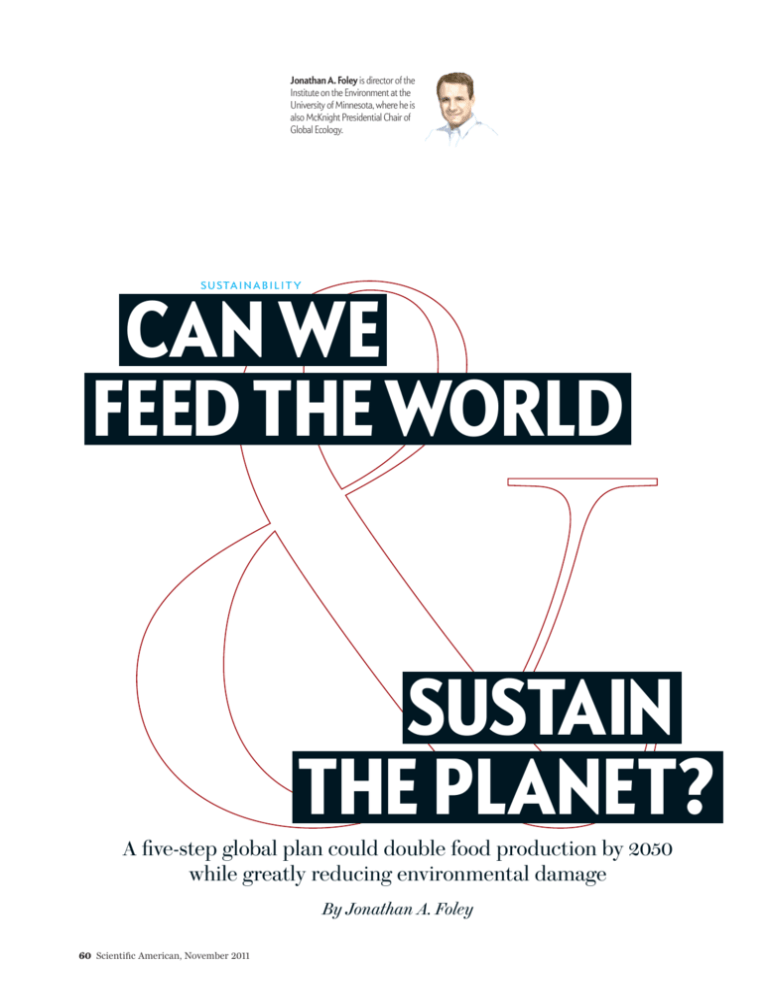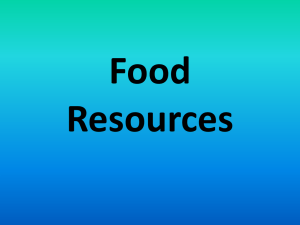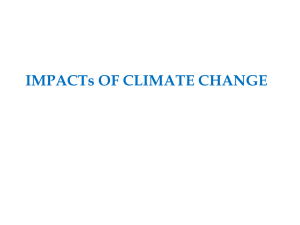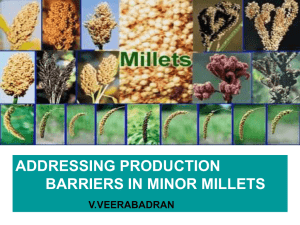Can We Feed the World SuStain the planet?
advertisement

Jonathan A. Foley is director of the Institute on the Environment at the University of Minnesota, where he is also McKnight Presidential Chair of Global Ecology. s u sta i n a b i l i t y Can We Feed the World Sustain the planet? A five-step global plan could double food production by 2050 while greatly reducing environmental damage By Jonathan A. Foley 60 Scientific American, November 2011 Photograph by Kevin Van Aelst November 2011, ScientificAmerican.com 61 ight now about one billion people suffer from chronic hunger. the world’s farmers grow enough food to feed them, but it is not properly distributed and, even if it were, many cannot afford it, because prices are escalating. But another challenge looms. By 2050 the world’s population will increase by two billion or three billion, which will likely double the demand for food, according to several studies. Demand will also rise because many more people will have higher incomes, which means they will eat more, especially meat. Increasing use of cropland for biofuels will make meeting the doubling goal more difficult still. So even if we solve today’s problems of poverty and access—a daunting task—we will also have to produce twice as much to guarantee adequate supply worldwide. And that’s not all. By clearing tropical forests, farming marginal lands and intensifying industrial farming in sensitive landscapes and watersheds, humankind has made agriculture the planet’s dominant environmental threat. Agriculture already consumes a large percentage of the earth’s land surface and is destroying habitat, using up freshwater, polluting rivers and oceans, and emitting greenhouse gases more extensively than almost any other human activity. To guarantee the globe’s long-term health, we must dramatically reduce agriculture’s adverse impacts. The world’s food system faces three incredible, interwoven challenges, then. It must guarantee that all seven billion people alive today are adequately fed; it must double food production in the next 40 years; and it must achieve both goals while becoming truly environmentally sustainable. Could these simultaneous goals possibly be met? An international team of experts, which I coordinated, has settled on five steps that, if pursued together, could raise by more than 100 percent the food available for human consumption globally, while significantly lessening greenhouse gas emissions, biodiversity losses, water use and water pollution. Tackling the triple challenge will be one of the most important tests humanity has ever faced. It is fair to say that our response will determine the fate of our civilization. Bumping Up against Barriers at first blush, the way to feed more people would seem clear: grow more food, by expanding farmland and improving yield— the amount of edible crops harvested per hectare. Unfortunately, the world is running into significant barriers on both counts. Society already farms roughly 38 percent of the earth’s land surface, not counting Greenland or Antarctica. Agriculture is by far the biggest human use of land on the planet; nothing else comes close. And most of that 38 percent covers the best farmland. Much of the remainder is covered by deserts, mountains, tundra, ice, cities, parks and other unsuitable growing areas. The few remaining frontiers are mainly in tropical forests and savannas, which are vital to the stability of the globe, especially as stores of carbon and biodiversity. Expanding into those areas is not a good idea, yet over the past 20 years five million to 10 million hectares of cropland a year has been created, with a significant portion of that in the tropics. These additions enlarged the net area of cultivated land by only 3 percent, however, because of farmland losses caused by urban development and other forces, particularly in temperate zones. Improving yield also sounds enticing. Yet our research team found that average global crop yield increased by about 20 percent in the past 20 years—far less than what is typically reported. That improvement is significant, but the rate is nowhere near enough to double food production by midcentury. Whereas yields of some crops improved substantially, others saw little gain and a few even declined. Feeding more people would be easier if all the food we grew went into human hands. But only 60 percent of the world’s crops are meant for people: mostly grains, followed by pulses (beans, lentils), oil plants, vegetables and fruits. Another 35 percent is used for animal feed, and the final 5 percent goes to biofuels and other industrial products. Meat is the biggest issue here. Even with the most efficient meat and dairy systems, feeding crops to animals reduces the world’s potential food supply. Typically, grain-fed cattle operations use 30 kilograms of grain to make one kilogram of edible, boneless beef. Chicken and pork are more efficient, and grass-fed beef converts nonfood material into protein. No matter how you slice it, though, grain-fed meat production systems are a drain on the global food supply. in brief The world must solve three food problems simultaneously: end hunger, double food production by 2050, and do both while drastically reducing agriculture’s damage to the environment. Five solutions, pursued together, can achieve these 62 Scientific American, November 2011 goals: stop agriculture from consuming more tropical land, boost the productivity of farms that have the lowest yields, raise the efficiency of water and fertilizer use worldwide, reduce per capita meat consumption and reduce waste in food production and distribution. A system for certifying foods based on how well each one delivers nutrition and food security and limits environmental and social costs would help the public choose products that push agriculture in a more sustainable direction. l ay o f t h e l a n d Farming Hits the Wall, But Not the Ceiling Humankind now farms 38 percent of the earth’s ice-free land. Crops cover one-third of that area; pastures and ranges for livestock cover the rest. Little room exists for expansion because most of the remaining land is deserts, mountains, tundra or urban. Still, farms in many existing areas could be more productive (insets). Type of Agriculture None 100% cropland 100% pasture Yield of Maize Farmland Maps courtesy of James Gerber, Institute on the Environment, University of Minnesota Far from maximum Close to maximum Another deterrent to growing more food is the cost in damage to the environment, which is already extensive. Only our use of energy, with its profound impacts on climate and ocean acidification, rivals the sheer magnitude of agriculture’s environmental insults. Our research team estimates that agriculture has already cleared or radically transformed 70 percent of the world’s prehistoric grasslands, 50 percent of the savannas, 45 percent of the temperate deciduous forests and 25 percent of the tropical forests. Since the last ice age, nothing has disrupted ecosystems more. Agriculture’s physical footprint is nearly 60 times that of the world’s pavements and buildings. Freshwater is another casualty. Humans use an astounding 4,000 cubic kilometers of water per year, mostly withdrawn from rivers and aquifers. Irrigation accounts for 70 percent of the draw. If we count only consumptive water use—water that is used and not returned to the watershed—irrigation climbs to 80 or 90 percent of the total. As a result, many large rivers such as the Colorado have diminished flows, some have dried up altogether, and many places have rapidly declining water tables, including regions of the U.S. and India. Water is not only disappearing, it is being contaminated. Fertilizers, herbicides and pesticides are being spread at incredible levels and are found in nearly every ecosystem. The flows of nitrogen and phosphorus through the environment have more than doubled since 1960, causing widespread water pollution and enormous hypoxic “dead zones” at the mouths of the world’s major rivers. Ironically, fertilizer runoff from farmland—in the name of growing more food—compromises another crucial source of Better Breadbaskets The world could grow much more food if the productivity of the poorest farms were raised toward the maximum possible, given climate and soil conditions. For example, the yield for maize (shown), could rise significantly across parts of Mexico, West Africa and Eastern Europe if seeds, irrigation, fertilizer and markets were improved. nutrition: coastal fishing grounds. Fertilizer certainly has been a key ingredient of the green revolution that has helped feed the world, but when nearly half the fertilizer we apply runs off rather than nourishes crops, we clearly can do better. Agriculture is also the largest single source of greenhouse gas emissions from society, collectively accounting for about 35 percent of the carbon dioxide, methane and nitrous oxide we release. That is more than the emissions from worldwide transportation (including all cars, trucks and planes) or electricity generation. The energy used to grow, process and transport food is a concern, but the vast majority of emissions come from tropical deforestation, methane released from animals and rice paddies, and nitrous oxide from overfertilized soils. Five Solutions modern agriculture has been an incredibly positive force in the world, but we can no longer ignore its dwindling ability to expand or the mounting environmental harm it imposes. Previous approaches to solving food and environmental issues were often at odds. We could boost food production by clearing more land or using more water and chemicals, but only at a cost to the environment. Or we could restore ecosystems by taking farmland out of cultivation, but only by reducing food production. This eitheror approach is no longer acceptable. We need truly integrated solutions. After many months of research and deliberation—based on analysis of newly generated global agricultural and environmental data—our international team has settled on a five-point plan November 2011, ScientificAmerican.com 63 s t r at e g y for dealing with food and environmental challenges together. Stop expanding agriculture’s footprint. Food production Our first recommendation is to slow and ultiBy 2050 global population will be mately stop the expansion of agriculture, partwo to three billion greater, and a ticularly into tropical forests and savannas. larger proportion of people will The demise of these ecosystems has far-reachhave higher incomes, so they will To feed the world without ruining the planconsume more per person. Farmers ing impacts on the environment, especially et, agriculture will have to produce much will need to grow twice as much as through lost biodiversity and increased carmore food (blue) and find better ways to they do today. bon dioxide emissions (from clearing land). distribute it (red), while significantly cutSlowing deforestation would dramatically ting the damage it does to the atmosphere, reduce environmental damage while imposhabitat and water (yellow). ing only minor constraints on global food production. The resulting dip in farm capacity could be offset by reducing the displacement of more productive croplands by urbanization, degradation and abandonment. Many proposals have been made to reduce deforestation. One of the most promising is the Reducing Emissions from Deforestation and Degradation (REDD) mechanism. Under REDD, rich nations pay tropical nations to protect their rain forests, in exchange for carbon credits. Other mechanisms include developing certification standards for agricultural products so that supply chains can be assured that crops were not grown on lands created by Food access deforestation. Also, better biofuel policy that More than one billion of the earth’s relies on nonfood crops such as switchgrass seven billion people suffer from Environmental damage instead of food crops could make vital farmchronic hunger. Poverty and poor To reduce harm, agriculture must stop distribution of food must be land newly available. expanding into tropical forests, raise the overcome to provide adequate Close the world’s yield gaps. To double globproductivity of underperforming farmland calories for everyone. al food production without expanding agri(which could boost production 50 to 60 percent), use water and fertilizer far more culture’s footprint, we must significantly imefficiently and prevent soil degredation. prove yields of existing farmlands. Two options exist: We can boost the productivity of our best farms—raising their “yield ceiling” through improved crop genetics and management. Or we can improve the yields of the world’s least produc- from organic and agroecological systems can also be adopted, tive farms—closing the “yield gap” between a farm’s current yield such as leaving crop residues on fields so they decompose into nuand its higher potential yield. The second option provides the trients. To close the world’s yield gaps, we also have to overcome largest and most immediate gain—especially in regions where serious economic and social challenges, including better distribuhunger is most acute. tion of fertilizer and seed varieties to farms in impoverished reOur research team has analyzed global patterns of crop yields gions and improving access to global markets for many regions. and found that much of the world has a significant yield gap. In Use resources much more efficiently. To reduce the environparticular, yields could increase substantially across many parts mental impacts of agriculture, low- and high-yield regions alike of Africa, Central America and eastern Europe. In these regions, must practice agriculture with vastly greater efficiency: far more better seeds, more effective fertilizer application and efficient ir- crop output per unit of water, fertilizer and energy. rigation could produce much more food on the same amount of On average, it takes about one liter of irrigation water to grow land. Our analysis suggests that closing the yield gap for the one calorie of food, although some places use much more. Our world’s top 16 crops could increase total food production by 50 to analysis finds that farms can significantly curb water use with60 percent, with little environmental damage. out much reduction in food production, especially in dry cliReducing yield gaps in the least productive agricultural lands mates. Primary strategies include drip irrigation (where water is may often require some additional fertilizer and water. Care will applied directly to the plant’s base and not wastefully sprayed have to be taken to avoid unbridled irrigation and chemical use. into the air); mulching (covering the soil with organic matter to Many other techniques can improve yield. “Reduced tillage” retain moisture); and reducing water lost from irrigation sysplanting techniques disturb less soil, preventing erosion. Cover tems (by lessening evaporation from canals and reservoirs). crops planted between food-crop seasons reduce weeds and add With fertilizers, we face a kind of Goldilocks problem. Some nutrients and nitrogen to the soil when plowed under. Lessons places have too few nutrients and therefore poor crop produc- Output Expands, Harm Contracts 64 Scientific American, November 2011 Graphic by Jen Christiansen tion, whereas others have too much, leading to pollution. Almost no one uses fertilizers “just right.” Our analysis shows hotspots on the planet—particularly in China, northern India, the central U.S. and western Europe—where farmers could substantially reduce fertilizer use with little or no impact on food production. Amazingly, only 10 percent of the world’s cropland generates 30 to 40 percent of agriculture’s fertilizer pollution. Among the actions that can fix this excess are policy and economic incentives, such as payments to farmers for watershed stewardship and protection, for reducing excessive fertilizer use, for improving manure management (especially manure storage, so less runs off into the watershed during a storm), for capturing excess nutrients through recycling, and for instituting other conservation practices. In addition, restoring wetlands will enhance their capacity to act as a natural sponge to filter out nutrients in runoff. Here again reduced tillage can help nourish the soil, as can precision agriculture (applying fertilizer and water only when and where they are needed and most effective) and organic farming techniques. Shift diets away from meat. We can dramatically increase global food availability and environmental sustainability by using more of our crops to feed people directly and less to fatten livestock. Globally, humans could net up to three quadrillion additional calories every year—a 50 percent increase from our current supply—by switching to all-plant diets. Naturally, our current diets and uses of crops have many economic and social benefits, and our preferences are unlikely to change completely. Still, even small shifts in diet, say from grain-fed beef to poultry, pork or pasture-fed beef, can pay off handsomely. Reduce food waste. A final, obvious but often neglected recommendation is to reduce waste in the food system. Roughly 30 percent of the food produced on the planet is discarded, lost, spoiled or consumed by pests. In rich countries, much of the waste takes place at the consumer end of the system, in restaurants and trash cans. Simple changes in our daily consumption patterns—reducing oversize portions, food thrown in the garbage, and the number of takeout and restaurant meals—could significantly trim losses, as well as our expanding waistlines. In poorer countries, the losses are similar in size but occur at the producer end, in the form of failed crops, stockpiles ruined by pests, or food that is never delivered because of bad infrastructure and markets. Improved storage, refrigeration and distribution systems can cut waste appreciably. Moreover, better market tools can connect people who have crops to those who need them, such as cell-phone systems in Africa that link suppliers, traders and purchasers. Although completely eliminating waste from farm to fork is not realistic, even small steps would be extremely beneficial. Targeted efforts—especially reducing waste of the most resource-intensive foods such as meat and dairy—could make a big difference. Moving toward a Networked Food System in principle, our five-point strategy can address many food security and environmental challenges. Together the steps could increase the world’s food availability by 100 to 180 percent, while significantly lowering greenhouse gas emissions, biodiversity losses, water use and water pollution. It is important to emphasize that all five points (and perhaps more) must be pursued together. No single strategy is sufficient to solve all our problems. Think silver buckshot, not a silver bullet. We have tremendous successes from the green revolution and industrial-scale agriculture to build on, along with innovations in organic farming and local food systems. Let’s take the best ideas and incorporate them into a new approach—a sustainable food system that focuses on nutritional, social and environmental performance, to bring responsible food production to scale. We can configure this next-generation system as a network of local agricultural systems that are sensitive to nearby climate, water resources, ecosystems and culture and that are connected through efficient means of global trade and transport. Such a system could be resilient and also pay farmers a living wage. One device that would help foster this new food system would be the equivalent of the Leadership in Energy and Environmental Design program now in place for constructing new commercial buildings sustainably. This LEED program awards increasingly higher levels of certification based on points that are accumulated by incorporating any of a wide range of green options, from solar power and efficient lighting to recycled building materials and low construction waste. For sustainable agriculture, foods would be awarded points based on how well they deliver nutrition, food security and other public benefits, minus their environmental and social costs. This certification would help us get beyond current food labels such as “local” and “organic,” which really do not tell us much about what we are eating. Instead we can look at the whole performance of our food—across nutritional, social and environmental dimensions—and weigh the costs and benefits of different farming approaches. Imagine the possibilities: sustainable citrus and coffee from the tropics, connected to sustainable cereals from the temperate zone, supplemented by locally grown greens and root vegetables, all grown under transparent, performance-based standards. Use your smartphone and the latest sustainable food app, and you will learn where your food came from, who grew it, how it was grown, and how it ranks against various social, nutritional and environmental criteria. And when you find food that works, you can tweet about it to your social network of farmers and foodies. The principles and practices of our different agricultural systems—from large-scale commercial to local and organic—provide the foundation for grappling with the world’s food security and environmental needs. Feeding nine billion people in a truly sustainable way will be one of the greatest challenges our civilization has ever faced. It will require the imagination, determination and hard work of countless people from all over the world. There is no time to lose. more to explore Global Consequences of Land Use. Jonathan A. Foley et al. in Science, Vol. 309, pages 570–574; July 22, 2005. Enough: Why the World’s Poorest Starve in an Age of Plenty. Roger Thurow and Scott Kilman. Public Affairs, 2010. Food Security: The Challenge of Feeding 9 Billion People. H. Charles J. Godfray et al. in Science, Vol. 327, pages 812–818; February 12, 2010. SCIENTIFIC AMERICAN ONLINE For more maps showing how food production can increase while environmental harm can decrease, see www.ScientificAmerican.com/nov2011/foley November 2011, ScientificAmerican.com 65







